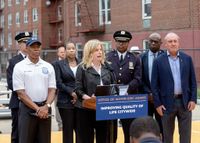New York City’s efforts to curb crime have come under intense scrutiny in recent weeks, following a pair of deaths in police custody and a heated debate over the city’s policing tactics. As the NYPD touts record-low shootings and a wave of gang takedowns, critics are questioning whether aggressive enforcement of low-level offenses and controversial policing tools are delivering safety—or deepening social divides.
The deaths of Musa Cetin and Christopher Nieves, both of whom died while in NYPD custody in late August, have reignited concerns about the human cost of the city’s approach. Cetin, a 29-year-old Turkish asylum seeker living in Brooklyn, was arrested in Midtown Manhattan on warrants tied to operating an unlicensed pedicab. According to NYPD officials, he was found hanged in his cell less than 15 minutes after officers last checked on him at around 8:20 p.m. on August 29. Emergency workers rushed him to Bellevue Hospital, where he remained on life support for two days before being pronounced dead on Sunday, August 31. Meanwhile, 46-year-old Christopher Nieves was arrested the same Friday for allegedly stealing food from a Whole Foods in Williamsburg, Brooklyn. While awaiting arraignment at Brooklyn Criminal Court, Nieves suffered a fatal medical episode around 10:15 p.m.
Both deaths are under investigation by the city’s Office of the Chief Medical Examiner and the NYPD’s Force Investigation Division. The incidents have drawn sharp criticism from defense attorneys and advocates, who argue that the city’s crackdown on minor offenses—often called “crimes of poverty”—is not only ineffective but potentially deadly. Arielle Reid, director of the Decarceration Project at the nonprofit Legal Aid Society, summed up the frustration: “Throw them in jail, throw them in jail, throw them in jail, but we don't actually get at what is causing the underlying behavior and attempt to solve that.”
These tragedies come as the NYPD, under Commissioner Jessica Tisch and Mayor Eric Adams, doubles down on enforcement of low-level crimes. Petit larceny arrests are on track to break records in 2025, with more than 14,000 made in the first six months alone. While complaints about petit larceny have fallen 10% since the pandemic, they remain 32% higher than in 2021. The push is part of a broader strategy to address public fears about safety in the wake of the pandemic, even as shootings and major crimes fall citywide.
Commissioner Tisch has repeatedly insisted that the NYPD is not reviving the controversial “broken windows” approach of policing minor offenses to prevent more serious crime. Yet, as she told reporters, the department is prioritizing these arrests to make New Yorkers feel safer. Mayor Adams has echoed this message, saying the city’s public safety plan is working, but he acknowledges that “numbers don’t tell everything” and that residents’ concerns must be addressed directly.
At the same time, the NYPD’s strategy has produced some headline-grabbing numbers. According to newly released statistics, major crimes in New York City declined by 6.7% in August 2025 compared to the same month last year. Shootings and gunshot victims have reached all-time lows through the first eight months of the year, with 489 incidents and 611 victims—beating previous records set in 2018. Commissioner Tisch credits the department’s focus on removing illegal guns, arresting violent gang members, and deploying officers on foot patrols for these gains. “Our strategy is working, and our cops are driving down crime,” Tisch said in a statement on September 2.
Yet the picture is hardly rosy across the board. Murders spiked 33% in August, fueled by a series of deadly shooting sprees in the Bronx and Manhattan. The city also saw a 24% increase in reported rapes last month compared to August 2024, marking the highest monthly total in at least six years. The NYPD attributes some of this rise to legislative changes that broadened the definition of rape and encouraged more survivors to come forward. Still, the numbers have stoked anxiety among residents and provided ammunition for critics of the city’s crime-fighting approach.
Nowhere is the debate more charged than around the NYPD’s gang database—a tool Commissioner Tisch has hailed as essential for identifying gang members and preventing retaliatory violence. “Much of the violence in The Bronx is gang-related. We know who the gang members are, thanks to a Criminal Group database. And know where they operate, so we’re going after them,” Tisch said recently. She also noted that 60% of shootings citywide are gang-related, and that the department has conducted more gang takedowns this year than ever before.
But the gang database has its detractors. Mayoral candidate Zohran Mamdani has vowed to dismantle it, arguing that it amounts to racial profiling since most individuals listed are black or Hispanic. Supporters of the database counter that it simply reflects the demographics of gangs and their victims, who are also overwhelmingly minorities. Critics warn that scrapping the tool would deprive police of critical intelligence and ultimately harm the very communities it’s meant to protect.
Commissioner Tisch’s approach has garnered praise from some quarters for its results. In August, major crimes dropped 7% compared to the previous year, making it the safest August on record for New York, according to NYPD data. Subway crime also hit record lows, excluding the pandemic years. Mayor Adams, for his part, remains steadfast in his support, stating, “We see so much promise in New York City, and it is readily apparent that our public safety plan is working.”
Still, the city faces political crosscurrents as it navigates its next steps. President Donald Trump has threatened to send the National Guard into cities with high crime rates, such as Chicago, and has not ruled out similar action in New York. Mayor Adams, however, insists that close coordination with state and federal partners makes such intervention unnecessary. “Our communication—we know the police commissioner met with the attorney general and shared what we’re doing here on the ground,” Adams said during a recent interview. He also brushed off speculation about his own political future, emphasizing his focus on serving the city and seeking reelection.
The NYPD’s strategy is not without its critics on the left and right. Defense attorneys and advocates for marginalized communities argue that aggressive policing of minor offenses only deepens cycles of poverty, addiction, and mental illness—particularly for immigrants and people of color. “If you have a client who is already part of an overpoliced immigrant population—such as pedicab drivers or street food vendors—what might normally only be a simple stop by the police could suddenly turn into an entire new arrest if an NYPD officer sees that person already has an open criminal case,” said Brian Ehrenpreis, a lawyer with New York County Defender Services who represented Cetin.
Meanwhile, supporters of the current approach warn that rolling back police powers or dismantling tools like the gang database would risk a return to higher crime rates and leave vulnerable communities less protected. Both Adams and Tisch have also criticized state-level reforms such as bail reform and “raise the age” laws, which they argue make it harder to keep repeat offenders off the streets.
As the city prepares for a new school year, Tisch outlined plans to deploy hundreds of officers along student travel corridors, underscoring the administration’s focus on visible policing and public reassurance. “Keeping our kids safe is our real priority this school year,” she said.
With New York’s crime numbers at historic lows in some categories and stubbornly high in others, the city sits at a crossroads—caught between the promise of safer streets and the perils of over-policing. The debate over how best to protect New Yorkers is far from settled, and the stakes could hardly be higher.






